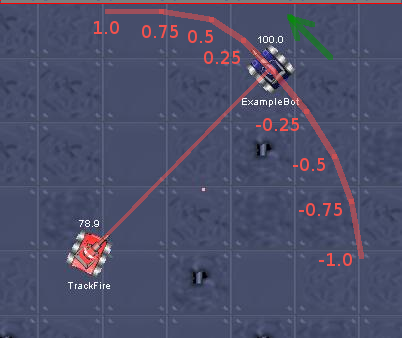Difference between revisions of "Maximum Escape Angle/Precise"
(Modifying the image's caption) |
(Fixing a link or two) |
||
| (One intermediate revision by one other user not shown) | |||
| Line 1: | Line 1: | ||
[[Image:GuessFactors.png|frame|A precise predicted maximum escape angle. Note that the counterclockwise angle is shorter than the clockwise angle because of the wall blocking the robot's path.]] | [[Image:GuessFactors.png|frame|A precise predicted maximum escape angle. Note that the counterclockwise angle is shorter than the clockwise angle because of the wall blocking the robot's path.]] | ||
| − | + | Many of the best targeting algorithms, particularly [[GuessFactor Targeting]], require the use of max escape angles. Although an absolute maximum escape angle can be calculated by <code>Math.asin(8 / bulletSpeed)</code> (as explained at [[Maximum Escape Angle]]), a true MEA can be restricted by walls and current heading and speed. As a result, the pixel-precision MEAs needed by [[:Category:Advanced Targeting Strategies|advanced targeting algorithms]] can only be obtained through [[Precise Prediction]]. A typical method is to predict the farthest distances the enemy could travel perpendicularly left and right, assuming the enemy will use a [[Wall Smoothing]] algorithm to maximize their escape angle. Once the farthest points are determined, the max escape angles of the target are equal to the absolute values of the [[bearing offset]]s of these points. | |
| − | + | [[Category:Terminology]] | |
Latest revision as of 01:38, 11 November 2009
Many of the best targeting algorithms, particularly GuessFactor Targeting, require the use of max escape angles. Although an absolute maximum escape angle can be calculated by Math.asin(8 / bulletSpeed) (as explained at Maximum Escape Angle), a true MEA can be restricted by walls and current heading and speed. As a result, the pixel-precision MEAs needed by advanced targeting algorithms can only be obtained through Precise Prediction. A typical method is to predict the farthest distances the enemy could travel perpendicularly left and right, assuming the enemy will use a Wall Smoothing algorithm to maximize their escape angle. Once the farthest points are determined, the max escape angles of the target are equal to the absolute values of the bearing offsets of these points.
